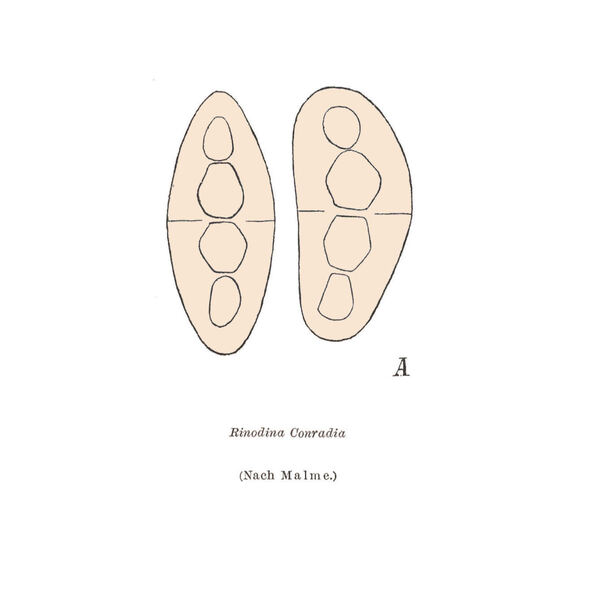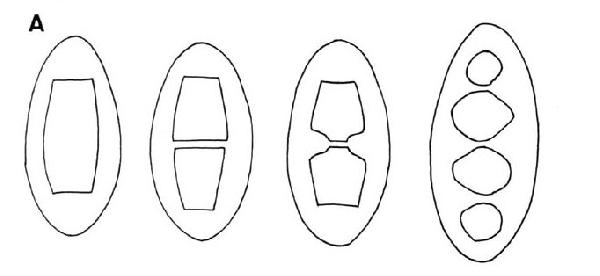Rinodina conradii Körb.
Syst. Lich. Germ.: 123, 1855.
Synonyms: Rinodina pyreniospora (Nyl.) Branth & Rostr.
Distribution: N - Frl (Tretiach & Hafellner 2000), Ven (TSB 13730), TAA (Nascimbene & al. 2004, 2004b), Lomb, Piem, Lig. C - Umb (Ravera & al. 2006, 2006b).
Description: Thallus crustose, episubstratic, usually thin, sometimes inconspicuous, continuous and smooth to finely rugose, cracked or rarely verrucose, pale grey to grey-brown, sometimes with a greenish tinge, usually not delimited by a distinct prothallus. Apothecia lecanorine, abundant and often crowded, 0.3-0.8(-1) mm across, sessile to adnate, with a dark brown to brown-black, flat to slightly convex disc and a distinct but thin, persistent thalline margin. Epithecium brown to red-brown, K-; hymenium colourless, 80-135 µm high; hypothecium colourless to pale yellow, (25-)35-60(-70) µm high. Asci 8-spored, clavate, the K/I+ blue tholus penetrated by a faintly amyloid apical cushion with parallel or diverging flanks, the wall K/I-, surrounded by a K/I+ blue outer layer, Lecanora-type. Ascospores at first 1-septate, then 3(-5)-septate, brown, ellipsoid, (18-)25-31(-35) x 9-15 µm, Conradii-type, the wall strongly thickened with an evident torus, the ontogeny of type B (apical wall thickened prior to septum formation). Pycnidia black, immersed. Conidia bacilliform, 3.5-4 µm long. Photobiont chlorococcoid. Spot tests: thallus K-, C-, KC-, P-, UV-. Chemistry: without lichen substances. Note: a widespread, short-lived early coloniser of base-rich soil and terricolous bryophytes in open habitats, sometimes on mosses on basal parts of ancient trees.
Growth form: Crustose
Substrata: soil, terricolous mosses, and plant debris
Photobiont: green algae other than Trentepohlia
Reproductive strategy: mainly sexual
Pioneer species
Commonnes-rarity: (info)
Alpine belt: absent
Subalpine belt: very rare
Oromediterranean belt: extremely rare
Montane belt: very rare
Submediterranean belt: extremely rare
Padanian area: absent
Humid submediterranean belt: absent
Humid mediterranean belt: absent
Dry mediterranean belt: absent
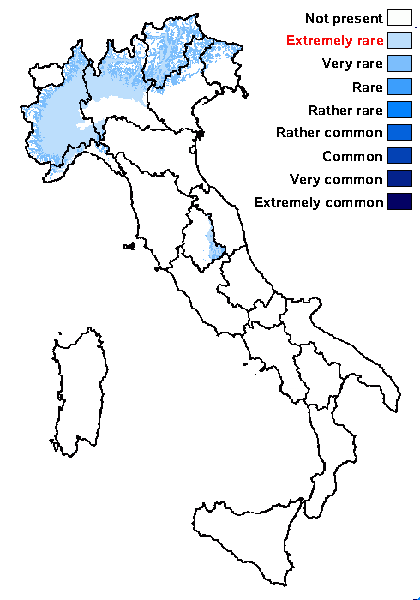
Predictive model
Herbarium samples


P.L. Nimis; Owner: Department of Life Sciences, University of Trieste
Herbarium: TSB (28978)
2003/03/06
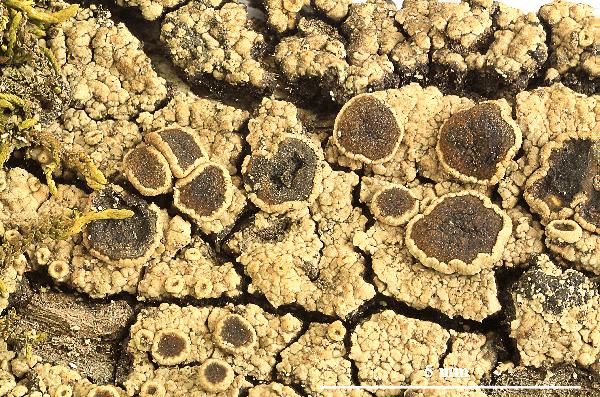

Felix Schumm - CC BY-SA 4.0
[ABL79622], Brazil, Rio Grande do Sul, Rio Pardo, Balneário Santa
Vitória, in Atlantic rain forest on tree bark (twig). 30°00'28'' S,
52°23'19'' W, 20 m. Leg. A. Aptroot (no 79622), 18 July 2019, det. A.
Aptroot 2019.
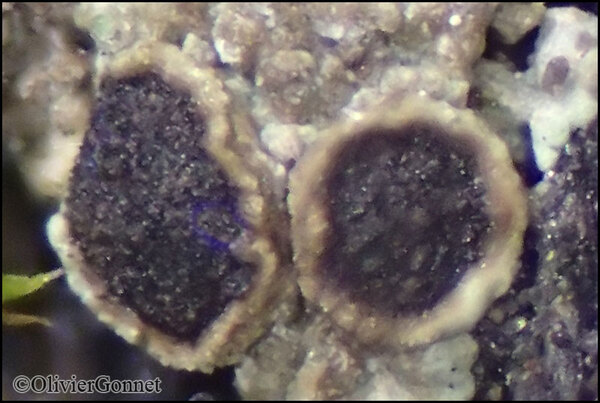
Courtesy Danièle et Olivier Gonnet - Source: https://www.afl-lichenologie.fr/Photos_AFL/Photos_AFL_R/Textes_R2/Rinodina_conradii.htm
France, 2/9/2014 - Savoie - (73) - Bonneval-sur-Arc, pont de l’Oulietta, alt. 2495 m - sur sol et mousses

Courtesy Danièle et Olivier Gonnet - Source: https://www.afl-lichenologie.fr/Photos_AFL/Photos_AFL_R/Textes_R2/Rinodina_conradii.htm
France, 2/9/2014 - Savoie - (73) - Bonneval-sur-Arc, pont de l’Oulietta, alt. 2495 m - sur sol et mousses

Courtesy Danièle et Olivier Gonnet - Source: https://www.afl-lichenologie.fr/Photos_AFL/Photos_AFL_R/Textes_R2/Rinodina_conradii.htm
France, 2/9/2014 - Savoie - (73) - Bonneval-sur-Arc, pont de l’Oulietta, alt. 2495 m - sur sol et mousses

Courtesy Danièle et Olivier Gonnet - Source: https://www.afl-lichenologie.fr/Photos_AFL/Photos_AFL_R/Textes_R2/Rinodina_conradii.htm
France, 2/9/2014 - Savoie - (73) - Bonneval-sur-Arc, pont de l’Oulietta, alt. 2495 m - sur sol et mousses
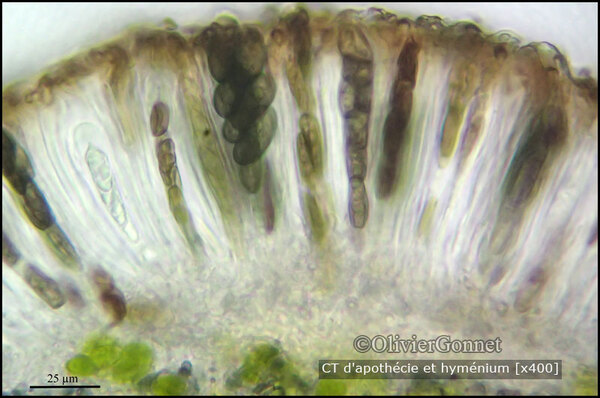
Courtesy Danièle et Olivier Gonnet - Source: https://www.afl-lichenologie.fr/Photos_AFL/Photos_AFL_R/Textes_R2/Rinodina_conradii.htm
France, 2/9/2014 - Savoie - (73) - Bonneval-sur-Arc, pont de l’Oulietta, alt. 2495 m - sur sol et mousses

Courtesy Danièle et Olivier Gonnet - Source: https://www.afl-lichenologie.fr/Photos_AFL/Photos_AFL_R/Textes_R2/Rinodina_conradii.htm
France, 2/9/2014 - Savoie - (73) - Bonneval-sur-Arc, pont de l’Oulietta, alt. 2495 m - sur sol et mousses
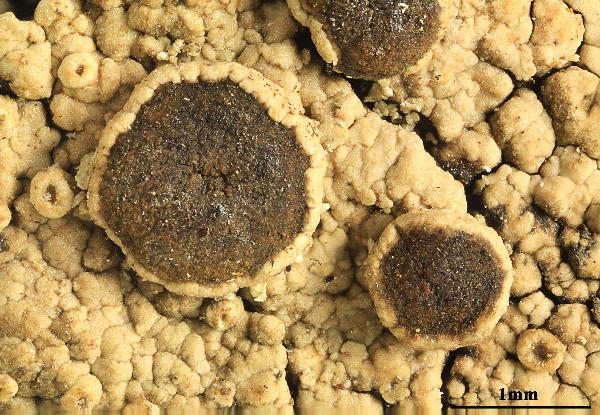

Felix Schumm - CC BY-SA 4.0
[ABL79622], Brazil, Rio Grande do Sul, Rio Pardo, Balneário Santa
Vitória, in Atlantic rain forest on tree bark (twig). 30°00'28'' S,
52°23'19'' W, 20 m. Leg. A. Aptroot (no 79622), 18 July 2019, det. A.
Aptroot 2019.
Growth form: Crustose
Substrata: soil, terricolous mosses, and plant debris
Photobiont: green algae other than Trentepohlia
Reproductive strategy: mainly sexual
Pioneer species
Commonnes-rarity: (info)
Alpine belt: absent
Subalpine belt: very rare
Oromediterranean belt: extremely rare
Montane belt: very rare
Submediterranean belt: extremely rare
Padanian area: absent
Humid submediterranean belt: absent
Humid mediterranean belt: absent
Dry mediterranean belt: absent

Predictive model
| Herbarium samples |


P.L. Nimis; Owner: Department of Life Sciences, University of Trieste
Herbarium: TSB (28978)
2003/03/06


Felix Schumm - CC BY-SA 4.0
[ABL79622], Brazil, Rio Grande do Sul, Rio Pardo, Balneário Santa Vitória, in Atlantic rain forest on tree bark (twig). 30°00'28'' S, 52°23'19'' W, 20 m. Leg. A. Aptroot (no 79622), 18 July 2019, det. A. Aptroot 2019.

Courtesy Danièle et Olivier Gonnet - Source: https://www.afl-lichenologie.fr/Photos_AFL/Photos_AFL_R/Textes_R2/Rinodina_conradii.htm
France, 2/9/2014 - Savoie - (73) - Bonneval-sur-Arc, pont de l’Oulietta, alt. 2495 m - sur sol et mousses

Courtesy Danièle et Olivier Gonnet - Source: https://www.afl-lichenologie.fr/Photos_AFL/Photos_AFL_R/Textes_R2/Rinodina_conradii.htm
France, 2/9/2014 - Savoie - (73) - Bonneval-sur-Arc, pont de l’Oulietta, alt. 2495 m - sur sol et mousses

Courtesy Danièle et Olivier Gonnet - Source: https://www.afl-lichenologie.fr/Photos_AFL/Photos_AFL_R/Textes_R2/Rinodina_conradii.htm
France, 2/9/2014 - Savoie - (73) - Bonneval-sur-Arc, pont de l’Oulietta, alt. 2495 m - sur sol et mousses

Courtesy Danièle et Olivier Gonnet - Source: https://www.afl-lichenologie.fr/Photos_AFL/Photos_AFL_R/Textes_R2/Rinodina_conradii.htm
France, 2/9/2014 - Savoie - (73) - Bonneval-sur-Arc, pont de l’Oulietta, alt. 2495 m - sur sol et mousses

Courtesy Danièle et Olivier Gonnet - Source: https://www.afl-lichenologie.fr/Photos_AFL/Photos_AFL_R/Textes_R2/Rinodina_conradii.htm
France, 2/9/2014 - Savoie - (73) - Bonneval-sur-Arc, pont de l’Oulietta, alt. 2495 m - sur sol et mousses

Courtesy Danièle et Olivier Gonnet - Source: https://www.afl-lichenologie.fr/Photos_AFL/Photos_AFL_R/Textes_R2/Rinodina_conradii.htm
France, 2/9/2014 - Savoie - (73) - Bonneval-sur-Arc, pont de l’Oulietta, alt. 2495 m - sur sol et mousses


 INDEX FUNGORUM
INDEX FUNGORUM
 GBIF
GBIF
 DOLICHENS
DOLICHENS

